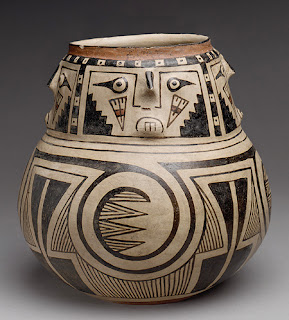Before I depart on the Spring, 2012 quarter I feel it is important, for the sake of resolving any misunderstandings about artistic integrity (and plagiarism), and subsequent considerations of expression to make a statement and full disclosure about the forms I borrow and use in my work.
Creativity is, in my opinion, little more than the combination of existing forms in unique ways, and I doubt if I have ever been creative in a classic sense, or created forms from nothing. Generally, I simply rearrange existing influences in novel and amusing patterns, much like a child might arrange kitchen chairs to create their own mystical cities of play. It seems to me that we all respond, for some unknown reason, to some forms and don’t respond in any pattern, to other forms.
Instead of creativity, I prefer to first address tradition. The tradition of porcelain, the tradition of pinch pots, the tradition of coil pots, the tradition of drinking coffee out of hollowed, and fired clay sculpture, the tradition of painting on pots, the traditions of surreal polychrome designs, the tradition of departing from established colors, based on what is available.

In Music, I have found that the successful musician must first establish a format upon which the listener is familiar and then depart from that format in unfamiliar and creative ways, musically. It is this over-layering of the familiar with the unfamiliar, often described as resolving disharmony with harmony, chord over discord, that I seek by in clay forms by presenting wondrous new sights and sounds, only enough to challenge but not so laborious as to confuse. Some hikers are more readily able to follow a practiced leader, and some chess players are more appreciative of challenge, but those conditions are entirely based on the artist who joins forms and has little to do with the carved expression which the fleeing artist leaves on our doorstep.
Until I come to a better understanding of the process of these considerations I plan to move ahead with my assumptions about creativity in the only way I know possible, based on what I think I know. To satisfy the requirements of honesty, necessary of all artists (and not just to satisfy the requirements of Independent study ceramics 299). I will make a renewed effort to give credit where credit is due, for the images I borrow, steal, conjole, as far as I am able to recognize them.

My “experiment in Puebla plychrome is heavily influenced on the plates of the books, (1) Secrets of Casas Grandes , Edited by Melissa S. Powell, and (2) Casas Grandes and the Ceramic Art of the Ancient Southwest, edited by Richard F. Townsend. My purpose is to replicate these pieces and thereby somehow better understand them . Perfect copies of the Casas Grandes pottery would, of course, be impossible so I will instead accept the simplified copies that I am able to “create”, hopefully deepening appreciation for them.
To these traditions I bow: The tradition of forming abstract and ridiculous portraitures of the human experience in clay, the tradition of making drinking vessels in the simplest manner possible, the tradition of replicating “antiqua” patterns of wear and use, the tradition of challenging the viewer, the drinker the looker, the inadvertent traveler, and those confused, the tradition of experimenting with the unexpected, comical, unfamiliar, impractical, mysteriously meaningful and sometimes maniacal, the tradition of traditions, and the time honored tradition of mistaken pathways, misunderstood directions, false starts, confusion, stupidity, irrational assumptions, and unconscious (and even) pathological manifestations of poorly understood physchosis, disguised as who we are, who we have been, what we think we know, who we may someday be, who we think we are, who we think we aren’t, and who we are unconsciously without ever thinking about it.

I suppose this introduction to my blog will deserve a follow-up at the end of the quarter to see if I have made any progress on this hastily drawn hypothesis. In short, I take no responsibility for anything I do but give everyone else, known and often unknown, all the credit. It is just that often I have no idea who those individuals are who deserve, so fully, the credit I might inadvertently and accidently receive from others/mh-2012
























